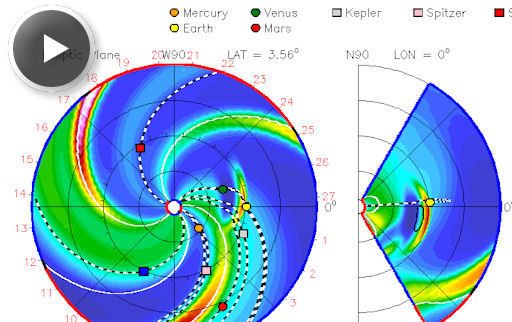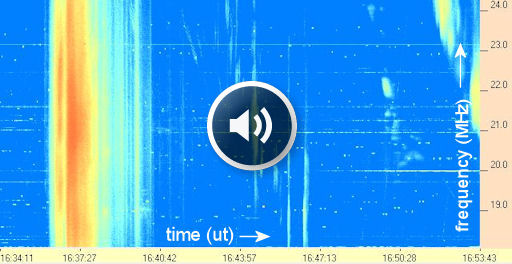They came from outer space--and you can have one! Genuine meteorites are now on sale in the Space Weather Store. | | |
HIGH SOLAR ACTIVITY: Behemoth sunspot AR1515 is crackling with M-class solar flares and appears to be on the verge of producing an X-class explosion. NOAA forecasters estimate an 80% chance of M-flares and a 10% chance of X-flares during the next 24 hours. X-flare alerts: text, voice.
INCOMING CME: On July 4th, sunspot AR1515 hurled at least four minor CMEs into space. Most flew south of the ecliptic plane (the orbital plane of the planets), on track to miss everything. One of them, however, appears to be heading toward Earth. Click to view an animated forecast track of the incoming cloud:

According to analysts at the Goddard Space Weather Lab, who prepared the forecast, the cloud will reach Earth on July 7th around 0600 UT. High-latitude sky watchers should be alert for auroras on that date. Aurora alerts: text, voice.
Realtime Space Weather Photo Gallery
SOLAR STATIC: Sunspot AR1513 erupted on the 4th of July, producing an M2-class solar flare and a burst of shortwave radio noise that roared out of the loudspeakers of receivers on Earth. Amateur radio astronomer Thomas Ashcraft of New Mexico recorded the solar static at 21 MHz:

Dynamic spectrum courtesy of Wes Greenman, Alachua Radio Observatory, FL
"While waiting for a potential X-flare in AR1515, I captured this 'radio-active' M-flare in AR 1513," says Ashcraft. "The audio sample contains two types of solar radio emission: The Type III solar bursting starts at 15 seconds and the Type V kicks in at around one minute or so."
These radio sounds are caused by beams of electrons accelerated by the flare. As the electrons slice through the sun's atmosphere, they generate a ripple of plasma waves and radio emissions detectable on Earth 93 million miles away. More radio bursts are in the offing as AR1515 and AR1513 crackle with magnetic explosions. Ham radio operators, point your Yagis toward the sun! X-flare alerts: text, voice.
Realtime Noctilucent Cloud Photo Gallery
[previous years: 2003, 2004, 2005, 2006, 2007, 2008, 2009, 2011]
Potentially Hazardous Asteroids (
PHAs) are space rocks larger than approximately 100m that can come closer to Earth than 0.05 AU. None of the known PHAs is on a collision course with our planet, although astronomers are finding
new ones all the time.
On July 5, 2012 there were potentially hazardous asteroids.
Recent & Upcoming Earth-asteroid encounters: | Asteroid | Date(UT) | Miss Distance | Mag. | Size |
| 2012 MY2 | Jun 29 | 1.3 LD | -- | 24 m |
| 2003 KU2 | Jul 15 | 40.2 LD | -- | 1.3 km |
| 2004 EW9 | Jul 16 | 46.8 LD | -- | 2.1 km |
| 2002 AM31 | Jul 22 | 13.7 LD | -- | 1.0 km |
| 37655 Illapa | Aug 12 | 37 LD | -- | 1.2 km |
| 2000 ET70 | Aug 21 | 58.5 LD | -- | 1.1 km |
| 1998 TU3 | Aug 25 | 49.2 LD | -- | 4.9 km |
| 2009 AV | Aug 26 | 62.8 LD | -- | 1.1 km |
Notes: LD means "Lunar Distance." 1 LD = 384,401 km, the distance between Earth and the Moon. 1 LD also equals 0.00256 AU. MAG is the visual magnitude of the asteroid on the date of closest approach. | | The official U.S. government space weather bureau |
| | The first place to look for information about sundogs, pillars, rainbows and related phenomena. |
| | Researchers call it a "Hubble for the sun." SDO is the most advanced solar observatory ever. |
| | 3D views of the sun from NASA's Solar and Terrestrial Relations Observatory |
| | Realtime and archival images of the Sun from SOHO. |
| | from the NOAA Space Environment Center |
| | the underlying science of space weather |

